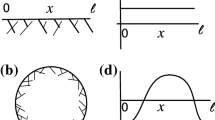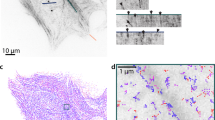Abstract
We formulate a motional model on the basis of an experimental optical trapping system which reveals the single molecular events of the force generation due to actin and myosin, and we discuss the origin of the dispersion of the displacements of the beads bound to the actin filament. In some experimental data sets, this dispersion is larger than that presumed from the model under the condition that the thermal agitation is the only source of the fluctuation. Thus, other fluctuating elements besides that due to thermal agitation are supposed to cause the dispersion. A possible fluctuating element is the step size itself. We discuss this possibility and estimate the fluctuation in step size using two reported experimental data sets.
Similar content being viewed by others
References
Bentil, D. E. (1998). Distribution of attachment events relative to actin binding sites as evidenced in a bidirectional actomyosin interaction model. Bull. Math. Biol. 19, 973–995.
Finer, J. T., R. M. Simmons and J. A. Spudich (1994). Single myosin molecule mechanics: piconewton forces and nanometre steps. Nature 368, 113–119.
Guilford, W. H., D. E. Dupuis, G. Kennedy, J. Wu, J. B. Patlak and D. M. Warshaw (1997). Smooth muscle and skeletal muscle myosins produce similar unitary forces and displacements in the laser trap. Biophys. J. 72, 1006–1021.
Goldman, Y. E. (1998). Wag the tail: structural dynamics of actomyosin. Cell 93, 1–4.
Highsmith, S. (1999). Lever arm model of force generation by actin-myosin-ATP. Biochemistry 38, 9791–9797.
Holmes, K. C. (1997). The swinging lever-arm hypothesis of muscle contraction. Curr. Biol. 7, R112–R118.
Ishijima, A., H. Kojima, T. Funatsu, M. Tokunaga, H. Higuchi, H. Tanaka and T. Yanagida (1998). Simultaneous observation of individual atpase and mechanical events by a single myosin molecule during interaction with actin. Cell 92, 161–171.
Kojima, H., A. Ishijima and T. Yanagida (1994). Direct measurement of stiffness of single actin filaments with and without tropomyosin by in vitro nanomanipulation. Proc. Natl Acad. Sci. USA 91, 12962–12966.
Kitamura, K., M. Tokunaga, A. H. Iwane and T. Yanagida (1999). A single myosin head moves along an actin filament with regular steps of 5.3 nm. Nature 397, 129–134.
Molloy, J. E., J. E. Burns, J. Kendrick-Jones, R. T. Tregear and D. C. S. White (1995). Movement and force produced by a single myosin head. Nature 378, 209–212.
Mehta, A. D., J. T. Finer and J. A. Spudich (1997). Detection of single-molecule interactions using correlated thermal diffusion. Proc. Natl Acad. Sci. USA 94, 7927–7931.
Mehta, A. D., R. S. Rock, M. Rief, J. A. Spudich, M. S. Mooseker and R. E. Cheney (1999). Myosin-V is a processive actin-based motor. Nature 400, 590–593.
Mehta, A. D. and J. A. Spudich (1998). Single myosin molecule mechanics. Adv. Struct. Biol. 5, 229–270.
Rayment, I., W. R. Rypniewski, K. Schmidt-Base, R. Smith, D. R. Tomchick, M. M. Benning, D. A. Winkelmann, G. Wesenberg and H. M. Holden (1993). Three-dimensional structure of myosin subfragment-1: a molecular motor. Science 261, 50–58.
Risken, H. (1989). The Fokker-Planck Equation, Berlin: Springer.
Smith, D. A. (1998). Direct tests of muscle cross-bridge theories: predictions of a brownian dumbbell model for position-dependent cross-bridge lifetimes and step sizes with an optically trapped actin filament. Biophys. J. 75, 2996–3007.
Tanaka, H., A. Ishijima, M. Honda, K. Saito and T. Yanagida (1998). Orientation dependence of displacements by a single one-headed myosin relative to the actin filament. Biophys. J. 75, 1886–1894.
Veigel, C., M. L. Bartoo, D. C. S. White, J. C. Sparrow and J. E. Molloy (1998). The stiffness of rabbit skeletal actomyosin cross-bridges determined with an optical tweezers transducer. Biophys. J. 75, 1424–1438.
Veigel, C., L. M. Coluccio, J. D. Jontes, J. C. Sparrow, R. A. Milligan and J. E. Molloy (1999). The motor protein myosin-I produces its working stroke in two steps. Nature 398, 530–533.
Vale, R. D. and R. A. Milligan (2000). The way things move: looking under the hood of molecular motor proteins. Science 288, 88–95.
Author information
Authors and Affiliations
Corresponding author
Rights and permissions
About this article
Cite this article
Kagawa, Y., Tsuchiya, Y. Stochasticity of the step size in the force generating process due to a single myosin molecule. Bull. Math. Biol. 64, 407–419 (2002). https://doi.org/10.1006/bulm.2002.0285
Received:
Accepted:
Issue Date:
DOI: https://doi.org/10.1006/bulm.2002.0285




